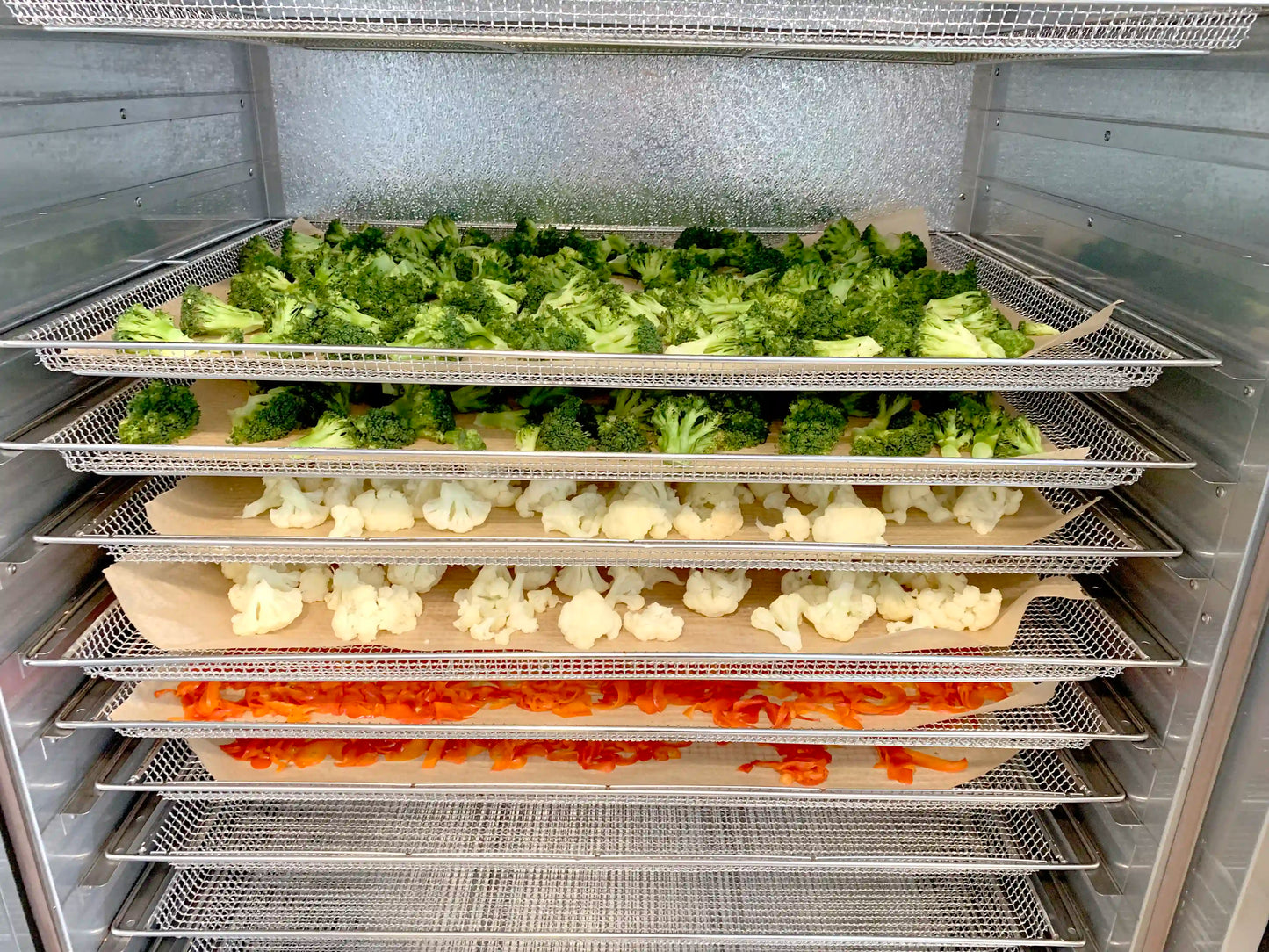
Wenn es um leichte, haltbare Nahrung für Abenteuer geht, sind dehydrierte und gefriergetrocknete Lebensmittel die beliebtesten Optionen. Doch welche ist besser? Beide Methoden entziehen zwar Feuchtigkeit, um die Haltbarkeit zu verlängern, sind aber nicht gleich – insbesondere in Bezug auf Geschmack, natürliche Verarbeitung und Praktikabilität.
Lassen Sie es uns aufschlüsseln.
1. Der Trocknungsprozess: Natürlich bleiben
Der Hauptunterschied zwischen dehydrierten und gefriergetrockneten Lebensmitteln liegt in der Art und Weise, wie das Wasser entfernt wird.
-
Dehydrierte Lebensmittel
Bei der Dehydration wird durch sanfte Hitze und Luftstrom die Feuchtigkeit auf natürliche Weise langsam entfernt, wodurch die Inhaltsstoffe erhalten bleiben. Diese Methode entfernt 85–95 % des Wassers und bewahrt gleichzeitig den ursprünglichen Geschmack.- Gängige Trocknungsmethoden: Lufttrocknen, Trocknen bei niedriger Temperatur oder Dörrgeräte. Hier bei Alpibreak verwenden wir ein Dörrgerät.
- Beispiel: Trockenfrüchte, Dörrfleisch, selbst gekochte Rucksackmahlzeiten.
-
Gefriergetrocknete Lebensmittel
Gefriertrocknung ist ein hochindustrialisierter Prozess, bei dem Lebensmittel zunächst auf extreme Temperaturen eingefroren und anschließend in ein Vakuum gegeben werden, sodass das Eis sublimiert (direkt in Dampf übergeht). Dabei werden 98–99 % der Feuchtigkeit entfernt, gleichzeitig verändert sich aber auch die Struktur der Lebensmittel.- Wird hauptsächlich für die Massenproduktion und extrem lange Haltbarkeit verwendet.
- Beispiel: Astronauteneis, gefriergetrocknete Erdbeeren, industrielle Menüpackungen.
Warum es wichtig ist: Die Dehydration ist ein natürlicherer Prozess , bei dem der ursprüngliche Geschmack und das Nährwertprofil der Lebensmittel ohne extremes Einfrieren oder Vakuumieren erhalten bleiben.
2. Geschmack und Konsistenz: Was fühlt sich mehr wie echtes Essen an?
-
Dehydrierte Lebensmittel
- Behält dank des natürlichen Trocknungsprozesses den tiefen, reichen Geschmack .
- Die Konsistenz kann je nach Zutat zäh oder leicht knusprig sein.
- Die Mahlzeiten werden rehydriert und erhalten die Konsistenz von selbstgekochten Lebensmitteln, ähnlich wie bei frischen Lebensmitteln
-
Gefriergetrocknete Lebensmittel
- Leichter und knuspriger vor der Wasserzugabe.
- Kann sich nach der Rehydrierung manchmal luftig oder zu weich anfühlen.
- Manche Gerichte verlieren durch die extreme Verarbeitung an Geschmackstiefe.
Warum es wichtig ist: Wenn Ihnen Geschmack und echte Textur wichtig sind, sorgt die Dehydrierung für ein authentischeres Esserlebnis.
3. Haltbarkeit & Lagerung: Was brauchen Sie wirklich?
- Dehydrierte Lebensmittel: 1–5 Jahre (perfekt für den regelmäßigen Gebrauch im Freien)
- Gefriergetrocknete Lebensmittel: Bis zu 25 Jahre (für extrem lange Lagerung konzipiert)
Warum das wichtig ist: Sofern Sie nicht gerade einen Weltuntergangsbunker planen, halten dehydrierte Mahlzeiten mehr als lange genug für echte Abenteuer und werden oft mit weniger Konservierungsstoffen hergestellt. Bei Alpibreak verwenden wir überhaupt keine Konservierungsstoffe.
4. Gewicht und Tragbarkeit: Leicht, aber nicht zu leicht
- Dehydrierte Lebensmittel sind kompakt und verpackbar , sodass sie leicht zu lagern und zu transportieren sind.
- Gefriergetrocknete Lebensmittel sind ultraleicht , benötigen aufgrund ihrer luftigen Struktur aber auch mehr Platz .
Warum es wichtig ist: Dehydrierte Lebensmittel bieten die perfekte Balance – leicht für unterwegs und dennoch kompakt genug, um Platz im Rucksack zu sparen.
5. Kosten und Zugänglichkeit: Warum mehr bezahlen?
- Dehydrierte Lebensmittel sind günstiger und können in kleinen Mengen mit echten Zutaten hergestellt werden.
- Gefriergetrocknete Lebensmittel sind aufgrund der hochtechnologischen Verarbeitung teuer und daher weniger zugänglich.
Warum es wichtig ist: Mit dehydrierten Mahlzeiten genießen Sie hochwertige Nährstoffe ohne die hohen Kosten der industriellen Gefriertrocknung.
Endgültiges Urteil: Warum Dehydration bei alltäglichen Abenteuern die beste Wahl ist
| Besonderheit | Dehydriert | Gefriergetrocknet |
|---|---|---|
| Feuchtigkeit entfernt | 85-95 % | 98-99% |
| Haltbarkeit | 1-5 Jahre | Bis zu 25 Jahre |
| Textur | Natürlich, reichhaltig | Leicht, luftig |
| Gewicht | Kompakt & effizient | Ultraleicht, aber sperrig |
| Rehydratationszeit | Schnell, wie selbstgekocht | Schnell, aber manchmal matschig |
| Kosten | Erschwinglich | Teuer |
| Am besten für | Mahlzeiten im Freien, hochwertiges Essen | Notfalllagerung |
Warum Alpibreak sich für Dehydration entscheidet
Wir bei Alpibreak glauben, dass Abenteuer mit echtem, leckerem Essen einhergehen sollten – nicht nur mit industriell hergestellten Überlebenspaketen. Deshalb verwenden wir Dehydration , eine natürliche, schonende Methode , die Aromen und Nährstoffe erhält und gleichzeitig den Transport und die Zubereitung der Mahlzeiten erleichtert.
Toller Geschmack, leicht und einfach Wasser hinzufügen.
Wenn Sie also das nächste Mal für eine Reise packen, fragen Sie sich: Möchten Sie richtiges Essen oder nur etwas zum Überleben?
Probieren Sie Alpibreak und schmecken Sie den Unterschied.
Was meint ihr? Habt ihr beide Gerichte schon probiert? Teilt es uns in den Kommentaren mit!
